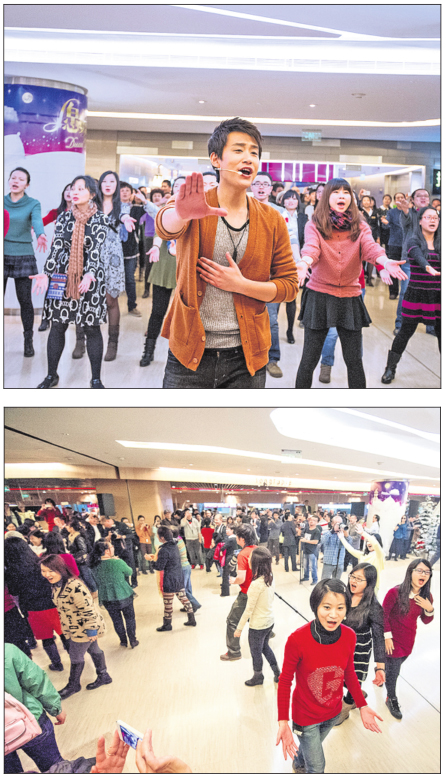
CHINA DAILY
Top and above: Members of three amateur choirs stage a flashmob performance at the China World Trade Center in Beijing.
During lunch time, the food court at the China World Trade Center is a jumble of tension and chaos. Suddenly, it is quieted by the loud, sonorous voice of a woman singing. Suddenly, people young and old, wearing face mics, stand up from among the crowd and move toward the center of the space, all the while singing old songs that call forth people's common memories.
The 11-minute flash-mob performance soon turned into a party, with some watchers filming with their cellphones and others joining in the singing and dancing. A short film of this performance reportedly attracted more than 3 million hits within a week on video websites, and it generated some 9 million re-posts on Sina Weibo, China's major micro-blog platform.
Feng Jinpeng, one of the performers and a member of CWTC workers' union choir, describes it as a once-in-a-lifetime experience. She used to watch flash mobs online but never expected to participate in one herself. She felt embarrassed and nervous at the beginning, but was soon overwhelmed by a feeling of warmth from the audience's reactions.
"We have a lot of white-collar people here. I seldom see them smile in normal situations, perhaps due to work pressure. You should see how breezily they smiled while watching the performance. It's so cozy," she says.
"You've got to take part in an event like this at least once in your life."
Such "action art" hasn't always been practical. The flash mob trend originated from New York in the early 2000s, where a man named Bill organized the first event featuring 500 people worshipping an animatronic T-rex dinosaur.
It soon caught on in China. One of the earliest was in Hangzhou in 2004, when some 400 people gathered in an open space to drink cola together. Better-known was a series of flash-mob dances organized by Chinese fans in recent years as part of a global campaign in memory of Michael Jackson.
A flash-mob scene usually features simple and brief physical actions, but the food-court production represented a new, professional level. It took four months of joint effort by three amateur choirs in the Chinese mainland and Taiwan. It also features Meng Nan, a star contestant at the Voice of China, and live show recording equipment. The performance was then made into a film by a professional team that produces TV commercials and music videos.
"A concert can have at most, thousands of people as an audience. And they don't always turn out to be touching. Isn't it better to deliver the warmth through our video to much more people at a much lower cost?" organizer Li Jian-fu says.
A former singer in Taiwan and now CEO of a Shanghai-based IT company, Li and his friends got their inspiration after seeing a man in Europe perform opera in a coffee house. They soon assembled their flash mob choir in Taiwan and did their first performance in Taipei 101 Tower, which created a stir online on both the island and the Chinese mainland.
Bringing it to Beijing was a bigger challenge. During the four months of preparations, according to the vice-director of CWTC mall Jing Chun, the three teams-the original one in Taipei and two participating choirs in Beijing-communicated with each other through the Internet and had their first secret rehearsal just three nights before the performance.
"It's sort of surprising that when they first jointly rehearsed, they smoothly went through the whole performance twice within one hour," Jing says.
After two acclaimed performances, Li was approached by various companies who wanted to piggyback on their success. But he refused them all.
"One thing they don't seem to understand is that, we're not doing this for business purposes. We purely want to give people happiness and warmth," Li says.
We recommend:
